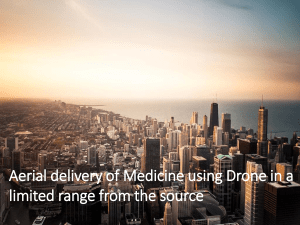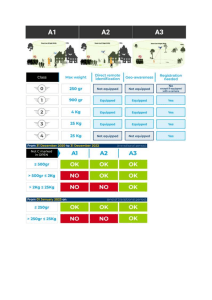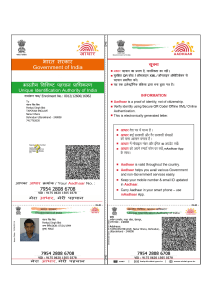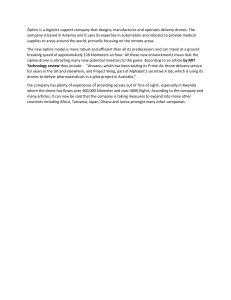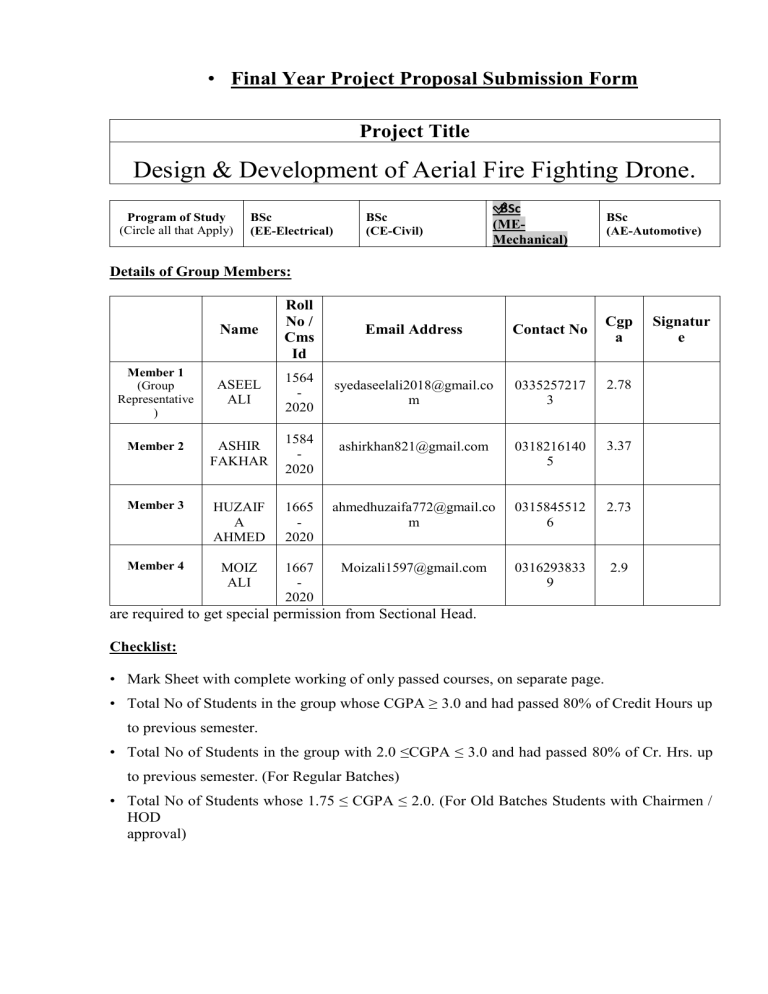
• Final Year Project Proposal Submission Form
Project Title
Design & Development of Aerial Fire Fighting Drone.
Program of Study
(Circle all that Apply)
BSc
(EE-Electrical)
BSc
(CE-Civil)
✅BSc
(MEMechanical)
BSc
(AE-Automotive)
Details of Group Members:
Name
Roll
No /
Cms
Id
Email Address
Contact No
ASEEL
ALI
1564
2020
syedaseelali2018@gmail.co
m
0335257217
3
2.78
Member 2
ASHIR
FAKHAR
1584
2020
ashirkhan821@gmail.com
0318216140
5
3.37
Member 3
HUZAIF
A
AHMED
1665
2020
ahmedhuzaifa772@gmail.co
m
0315845512
6
2.73
Member 4
MOIZ
ALI
1667
2020
Moizali1597@gmail.com
0316293833
9
2.9
Member 1
(Group
Representative
)
Cgp
a
Signatur
e
are required to get special permission from Sectional Head.
Checklist:
• Mark Sheet with complete working of only passed courses, on separate page.
• Total No of Students in the group whose CGPA ≥ 3.0 and had passed 80% of Credit Hours up
to previous semester.
• Total No of Students in the group with 2.0 ≤CGPA ≤ 3.0 and had passed 80% of Cr. Hrs. up
to previous semester. (For Regular Batches)
• Total No of Students whose 1.75 ≤ CGPA ≤ 2.0. (For Old Batches Students with Chairmen /
HOD
approval)
Supervisor, Co-Supervisor and External Supervisor Details:
I/We recommended that the proposed project is relevant to the program of study and to the
current developments and trends. The project will be beneficial for the students and can be
completed within given time and mentioned resources.
Name
Supervisor
Co-Supervisor
ENGR. ARIF
RUB
ENGR. M.
AHSAN
Name
Designation
Department
LECTURER
BSc. MET
ASST.
PROFESSOR
BSc. EET
Designation
(PEC No If
Any)
Department
Company Name
Signature
Signature
External
Supervisor (In
case of Industry
Based Project)
Funding/Sponsoring Organization (If Any: Attach Letter of Concerned Organization):ù
Project Type (Please mark�):
Nature of Project (Please mark�):
Literature Review and Executive Summary (300 words):
LITERATURE REVIEW:
Design and Fabrication of an Axphyxiator Drone (Firefighting Drone) with Maximum
Altitude of 40 ft. Using MATLAB, Arduino IDE, and PID Controllers.
The design and fabrication of firefighting drones, commonly referred to as axphyxiator drones,
have garnered significant attention in recent years due to their potential to revolutionize
firefighting efforts. This literature review presents a comprehensive overview of previous
research and publications focused on the development of firefighting drones with a maximum
altitude of 40 ft. The integration of MATLAB, Arduino IDE, and PID controllers is explored as key
components in achieving stable and effective firefighting operations
Numerous studies have highlighted the critical role that firefighting drones can play in
emergency situations. Leveraging their agility and remote capabilities, these drones can provide
real-time surveillance, situational awareness, and even deploy fire suppressants to combat
wildfires.
Research indicates that the integration of MATLAB and Arduino IDE offers a powerful platform
for developing sophisticated control algorithms and strategies. MATLAB's computational
capabilities enable advanced simulations and optimization of control parameters, aiding in PID
tuning and performance assessment.
The limitation of a 40 ft maximum altitude is often imposed by regulatory requirements to ensure
airspace safety. However, innovative approaches to obstacle detection, terrain mapping, and
cooperative navigation have been explored to mitigate these altitude constraints while
maintaining safety protocols.
In conclusion, the research and publications reviewed underscore the promising potential of
axphyxiator drones (firefighting drones) equipped with PID controllers, designed and fabricated
using MATLAB and Arduino IDE. These integrated technologies not only enhance firefighting
capabilities but also showcase the continuous advancement of drone technology in addressing
critical real-world challenges.
EXECUTIVE SUMMARY:
This executive summary provides an overview of research conducted on the design and
fabrication of firefighting drones, known as axphyxiator drones, with a maximum altitude of 40 ft.
The study emphasizes the utilization of MATLAB, Arduino IDE, and PID controllers to achieve
effective and stable firefighting operations.
This executive summary provides an overview of research conducted on the design and
fabrication of firefighting drones, known as axphyxiator drones, with a maximum altitude of 40 ft.
The study emphasizes the utilization of MATLAB, Arduino IDE, and PID controllers to achieve
effective and stable firefighting operations.
. Objectives and Deliverables:
{Specify the tasks/objectives which you are planning to achieve through this project, work which
is required to be completed for achieving them and deliverables which you will be giving in the
end e.g., a prototype, simulation, an algorithm or a design; relevant to Final Scoring}
Fire Suppression Mechanism: Design a fire suppression mechanism (e.g., water spraying
system) to extinguish the detected fire.Implement control logic to activate the fire suppression
mechanism accurately.
Prototype Drone: Physical drone with integrated components, including camera, obstacle
sensors, and fire suppression mechanism.
Fire Suppression Mechanism Implementation: Control logic and code for activating the fire
suppression mechanism upon fire detection.
Project Documentation: Detailed project report including system architecture, algorithm
explanations, hardware specifications, and integration steps.
Demonstration and Presentation: Presentation showcasing the project's objectives,
development process, and outcomes.Live demonstration of the firefighting drone in action,
highlighting its key features
General Block Diagram:
{Show flow of project in the form of Block Diagram}
Beneficiaries:
{Specify communities or sectors directly and indirectly benefiting from this project. State; who
and how (use bullets)}
Direct Beneficiaries:
Firefighters: Firefighters gain a powerful tool for battling fires more efficiently and safely.
Emergency Responders: Improved situational awareness helps responders coordinate efforts
during emergencies.
First Responders: Drones aid in search and rescue missions, enhancing their ability to locate
and assist individuals.
Victims of Fires: Quicker response times and more effective firefighting help minimize damage
to homes and property.
Indirect Beneficiaries:
Civilian Population: Reduced fire risks improve safety and quality of life for residents.
Agriculture: Drones can help prevent wildfires from damaging crops and farmland.
Power and Utility Companies: Enhanced fire monitoring prevents damage to infrastructure and
service interruptions.
Major Equipment’s required for making prototype/working model (Rough Idea):
Equipment’s Name
S. No.
1.
Quadcopter Frame.
Details
Base Model for Components
Approximate
Estimated
Cost
Rs 2950/=
Installation.
2.
Landing Gear.
Provides a stable platform
Rs 1880/=
for take-off & Landing.
3.
Propellers.
To Generate Thrust and
Rs 490/=
Take-off the Drone.
4.
Arduino UNO Boards.
For Flight Controlling &
Rs 1850/=
Program Language
Integration.
5.
6.
Lithium Polymer (LiPo)
To power Supply the
Batteries.
Controlling System.
Motors.
Allows Drone to perform
Rs 2900/=
Rs 2500/=
different Maneuvers such as,
Turning, Flipping,Rolling &
Hovering.
7.
Electronic Speed
Controls Drone’s Motor
Controller(ECS).
Speed based on Flight
Rs 1350/=
Controller’s Command.
8.
Radio Transmitter.
9.
Radio receiver.
Sends Command to the
drone & communicate with
the on-board flight
controller.
Radio receiver is a device
Rs 6000/=
Rs 3500/=
capable of receiving
commands from radio
transmitter.
10.
Gyroscope.
Measure the rate of rotation
& help keeps the drone
balance.
Rs 1190/=
List of Accessed Resources:
{Specify most important Human/Internet/Literature resources which you accessed for proposal}
Faculty Supervisors: Design & Fabrication Guidance from Sir Arif Rub, Flight Controlling
Operations Guidance from Sir Ahsan.
Online Research Journals: Accessed scholarly articles and research papers related to the
project's field.
https://www.researchgate.net/publication/362908663_A_Short_Review_of_the_Drone_Technol
ogy
Literature Resources:
Referenced relevant Article and Drone Manufacturing Company’s manual & Specification.
Youtube Tutorials.
https://youtu.be/9DKLD_eyEDQ
https://www.youtube.com/watch?v=8vMTZqvSl5s&t=0s
https://www.youtube.com/watch?v=MOF_mfgfl10&t=0s
https://youtu.be/EVDpyB91xNg
Project Management (150 words + Gantt Chart):
{Break your work into number of tasks and associate a logical sequence to them and write those
tasks in a given box. Generate Gantt chart to mark timelines also mark key miles stones
achieved/deliverables in a result of completing an intermediate task. Highly Relevant to Final
Scoring}
Project Initiation:
• Discuss project objectives and scope & Planning a Roadmap.
• Gather Team Members & Specify Designated Work.
Research and Requirements Gathering:
• Study existing fire-fighting technologies and drone capabilities.
• Gather requirements for the drone's design, payload, and firefighting mechanisms.
Conceptual Design and Prototyping:
• Create initial drone design and architecture.
• Develop a prototype to test firefighting mechanisms and flight performance.
Component Selection and Procurement:
• Choose suitable motors, sensors, actuators, and materials.
• Procure necessary components and establish partnerships with suppliers.
Integration and Testing:
• Assemble components and integrate firefighting equipment.
• Conduct thorough testing of drone systems, including flight stability and payload
delivery.
Software Development:
• Develop flight control algorithms and autonomous features.
• Implement safety protocols and emergency response mechanisms.
Testing and Optimization:
• Conduct field tests for firefighting effectiveness and operational efficiency.
• Refine drone performance based on test results.
Documentation and Reporting:
• Create comprehensive documentation, including user manuals and technical reports.
• Prepare a final project report highlighting achievements and lessons learned.
Gantt Chart:
| Task
| Start Date | End Date
|
Milestones/Deliverables
|
|--------------------------------|------------|------------|---------------------------------------|
| Project Initiation
| 01/05/2023 | 01/10/2023 | Project
objectives defined
|
| Research and Requirements
| 01/11/2023 | 02/15/2023 |
Requirements gathered
|
| Conceptual Design
| 02/16/2023 | 03/10/2023 | Prototype
design completed
|
| Component Selection
| 03/11/2023 | 03/30/2023 |
Components selected and procured
|
| Integration and Testing
| 04/01/2023 | 05/15/2023 | Drone
assembled and tested
|
| Software Development
| 05/16/2023 | 06/30/2023 | Flight
algorithms developed
|
| Testing and Optimization
| 07/01/2023 | 08/15/2023 | Field
tests completed
|
| Documentation and Reporting
| 08/16/2023 | 09/10/2023 | Final
report and documentation ready
|
This Gantt chart outlines the project timeline, key tasks, and associated milestones or
deliverables. The timeline is a visual representation of the project's progression, showing how
each task is scheduled and how milestones are achieved along the way.
Tasks
Jan
Feb
March April
May
June
July
Aug
Sept
Oct
Nov
Dec
Task 1
Task 2
Task 3
Task 4
Task 5
Task 6
Task 7
Task 8
Report
Writing
I/ We understand that the finished work/prototype/ working model/demo material including any
software and/ or hardware will be the property of FEST, Hamdard University.
____
Group Member 1
Member 4
Signature
Signature
_____
Group Member 2
Group Member 3
Signature
Signature
Group
Proposal Defense Presentation Details
(Office use only)
Presentation held on (Day and Date): _______________________________________
Evaluators Details:
Recommendations
Name
Department
&
Designation
Signature
1st
Evaluator
2nd
Evaluator
Project Approved? (Circle that Apply)
Yes
Conditional
Reason For Conditional:
No
1st
Evaluation
Targets
________________________
____________________________
Project Supervisor
Chairman
(Signature and Date)
Departmental
(Signature and Date)



